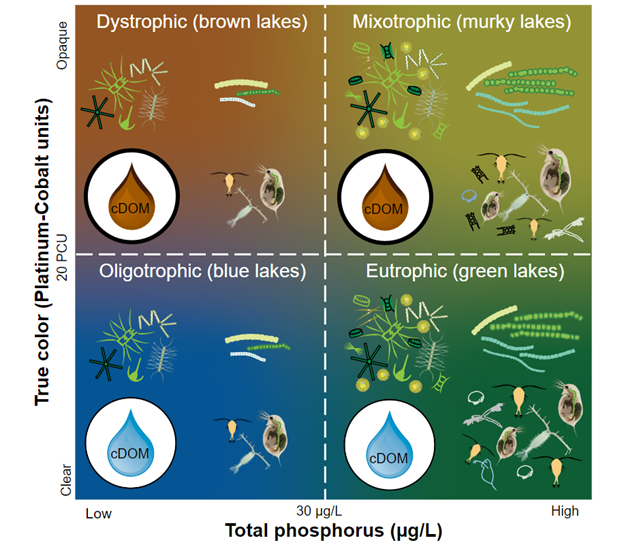Featured Data
The Lake Trophic State - US (LTS-US) Dataset
October 17, 2023
Michael Meyer
Citation
Meyer, M.F., S.N. Topp, T.V. King, R. Ladwig, R.M. Pilla, H.A. Dugan, J.R. Eggleston, S.E. Hampton, D.M. Leech, I.A. Oleksy, J.C. Ross, M.R. Ross, R.I. Woolway, X. Yang, M.R. Brousil, K.C. Fickas, J.C. Padowski, A.I. Pollard, J. Ren, and J.A. Zwart. 2023. National-scale, remotely sensed lake trophic state (LTS-US) 1984-2020 ver 1. Environmental Data Initiative. https://doi.org/10.6073/pasta/212a3172ac36e8dc6e1862f9c2522fa4.
Description
This data package is an excellent example of using merging remote sensing, in situ, national-scale sampling campaigns, and discipline-specific expertise to expand the spatial and temporal scope of freshwater science.
Recently, the LTS-US has been highlighted as a U.S. Geological Survey Open Science Success Story, an initiative stemming from the White House's Office of Science and Technology's declaration of 2023 as the Year of Open Science. In particular, the LTS-US dataset's highly detailed metadata and scripts in tandem with a completely reproducible compute environment earned the LTS-US dataset accolades among USGS data librarian and curation specialists.
The LTS-US dataset brings together over 35 years of Landsat surface reflectance data with the U.S. Environmental Protection Agency's National Lake Assessment's data to both construct and apply models that discriminate between blue (i.e., oligotrophic), green (i.e., eutrophic/mixotrophic), and brown (i.e., dystrophic) lakes. By classifying lakes based on Nutrient-Color Paradigm (NCP) groupings, the LTS-US Dataset presents a powerful tool for assessing both autochthonous and allochthonous components of aquatic ecosystems, which can lend further information into an ecosystem's physical, chemical, and biological processes.

Beyond the LTS-US's contribution to freshwater science, the LTS-US employs a range of data science and open science tools to support scalability and reproducibility as software evolves and new data become available. 1. The LTS-US dataset is constructed using the targets` Workflow Management Software, a tool that enables future users to automatically re-run the data processing pipeline. 2. The LTS-US dataset is produced in a ensemble-inspired framework, where each time the pipeline is run, predictions of a given lakes's trophic state are generated using 3 modeling techniques: a gradient boosted regression, logistic regression, and miltilayer perceptron model. 3. The LTS-US compute environment is containerized within a Docker Image that is available from the Environmental Data Initiative. Depending on future users' experience working with Docker, the container is available as an already rendered image or in an uncompiled format.
Together, the LTS-US dataset is the largest, reproducible, and machine-readable compilation of lake trophic state, by containing annual predictions for over 55,000 lakes from 1984 through 2020.
We welcome any future questions on using and reproducing the LTS-US dataset. Questions can be directed to Michael Meyer (mfmeyer@usgs.gov).
References
-
Leech, D. M., A. I. Pollard, S. G. Labou, and S. E. Hampton. 2018. Fewer blue lakes and more murky lakes across the continental U.S.: Implications for planktonic food webs. Limnology and Oceanography 63: 2661–2680. doi:10.1002/lno.10967
-
Meyer, M. F., S. N. Topp, T. V. King, and others. 2023. National-scale, remotely sensed lake trophic state (LTS-US) 1984-2020. Environmental Data Initiative. doi:10.6073/pasta/212a3172ac36e8dc6e1862f9c2522fa4
-
Webster, K. E., P. A. Soranno, K. S. Cheruvelil, and others. 2008. An empirical evaluation of the nutrient-color paradigm for lakes. Limnology and Oceanography 53: 1137–1148. doi:10.4319/lo.2008.53.3.1137
-
Williamson, C. E., D. P. Morris, M. L. Pace, and O. G. Olson. 1999. Dissolved organic carbon and nutrients as regulators of lake ecosystems: Resurrection of a more integrated paradigm. Limnology and Oceanography 44: 795–803. doi:10.4319/lo.1999.44.3_part_2.0795